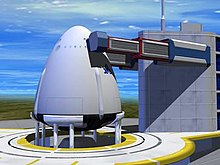Kankoh-maru
Appearance
 Artist's concept of Kankoh-maru | |
| Function | Crewed re-usable rocket |
|---|---|
| Country of origin | Japan |
| Size | |
| Height | 23.5 m (77 ft)[1] |
| Diameter | 18 m (59 ft)[1] |
| Mass | 550 t (1,210,000 lb)[1] |
| Stages | 1 |
| Capacity | |
| Payload to LEO | |
| Mass | 50 t (110,000 lb)[2] |
| Launch history | |
| Status | Proposed[3] |
| First stage | |
| Thrust | 6,888,000 N (1,548,000 lbf) [1] |
| Boosters | |
| Total thrust | 2,900,000 N (650,000 lbf) [1] |
The Kankoh-maru (観光丸, Kankōmaru) is a proposed vertical takeoff and landing (VTVL), single-stage-to-orbit (SSTO), reusable launch system (rocket-powered spacecraft). According to a document from July 1997, it would have been manufactured by Kawasaki Heavy Industries and Mitsubishi Heavy Industries, with its formal name being the Kawasaki S-1.[1]
Overview
[edit]The concept was created by the Japanese Rocket Society [ja] in 1993.[3] This development cost was estimated ¥3.8 billion (1995) (US$40.4 million) in 1995.[4]
The name Kankō Maru is derived from the first steam-powered vessel in Edo-era Japan.[3]
See also
[edit]- Chrysler SERV
- VentureStar
- Reusable Vehicle Testing program by JAXA/ISAS
- Blue Origin New Shepard
- Falcon 9 Full Thrust
References
[edit]- ^ a b c d e f Anderson, Erik (July 1997). "Kankoh-maru Flight Manual". Space Future. Archived from the original on 2012-11-26. Retrieved 2012-08-04.
- ^ "Kankoh Maru". astronautix.com. Retrieved January 28, 2023.
- ^ a b c Isozaki, Kohki; Yonemoto, Koichi; Kitayama, Osamu; Miyahara, Akira; Watanabe, Hiroyuki; Okaya, Shunichi; Ibusuki, Masayuki (1998). "Status Report on Space Tour Vehicle "Kankoh-maru" of Japanese Rocket Society". International Astronautical Federation 1998. Retrieved January 28, 2023.
- ^ 準軌道宇宙旅行 宇宙丸 - 観光丸 [Suborbital space tourism Uchumaru - Kankoh-maru] (in Japanese). uchumaru.com. 2005-04-11. Retrieved 2011-07-24.
External links
[edit]- Encyclopedia Astronautica entry
- 宇宙旅行アーカイブ (Space Tourism Archive), Space Liner Association
